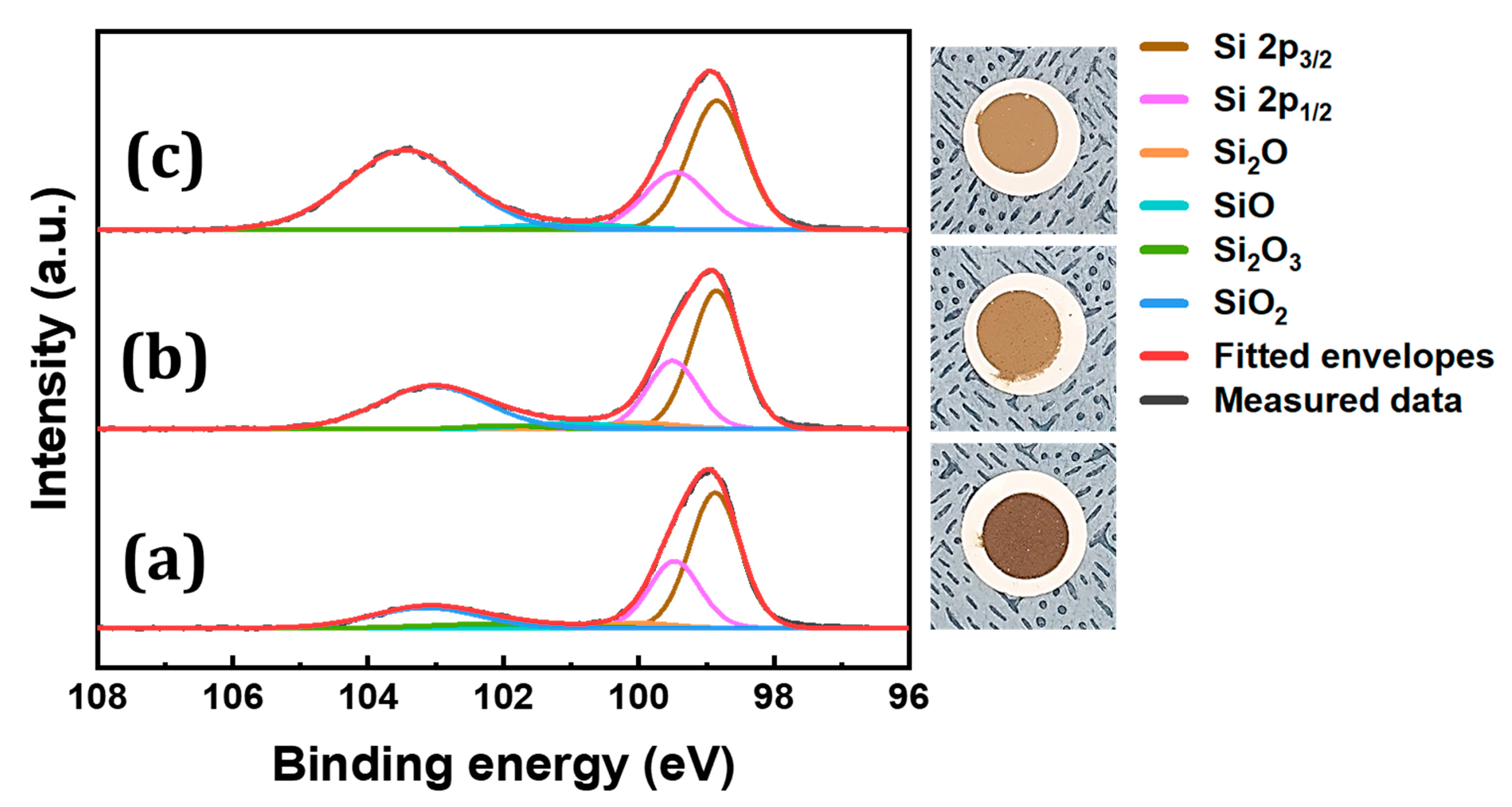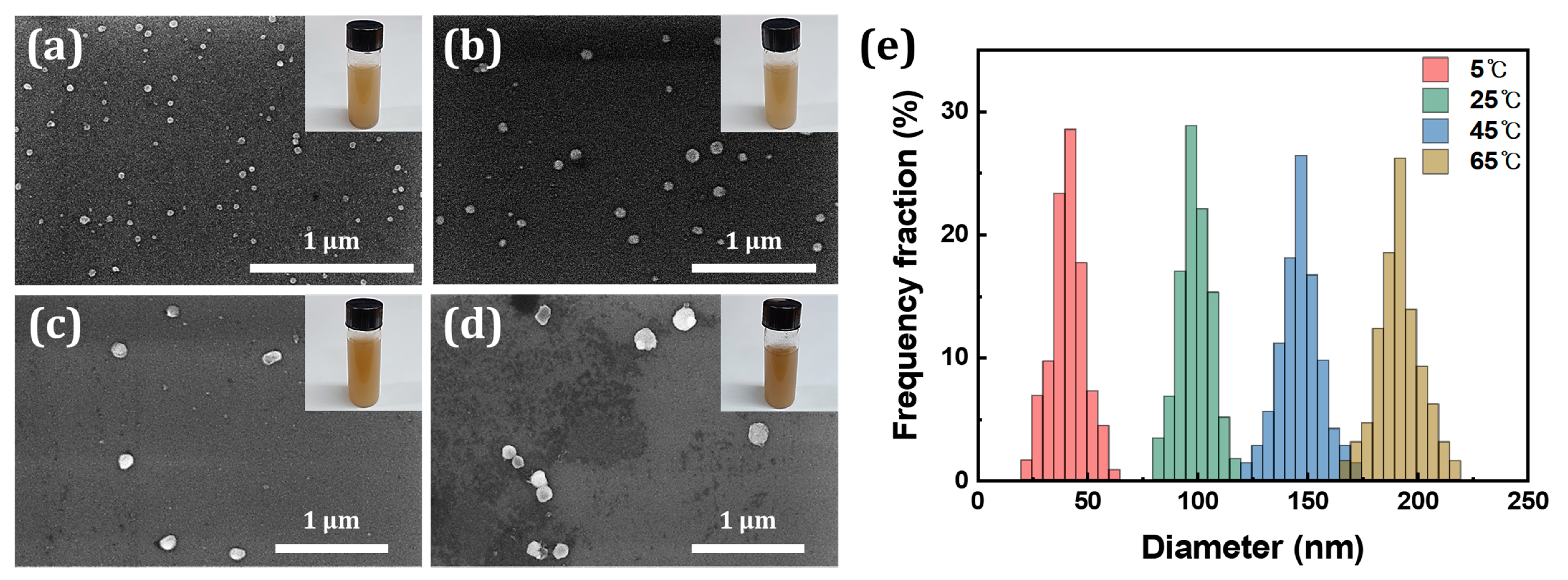Oxygen Content-Controllable Synthesis of Non-Stoichiometric Silicon Suboxide Nanoparticles by Electrochemical Anodization
Abstract
1. Introduction
2. Materials and Methods
2.1. Materials
2.2. SiOx NPs Preparation
2.3. Characterization
3. Results and Discussion
3.1. Synthesis of Silicon Oxide NPs
3.2. Control of Oxygen Content in SiOx NPs
3.3. Size Control of SiOx NPs
4. Conclusions
Supplementary Materials
Author Contributions
Funding
Conflicts of Interest
References
- Jung, C.-O.; Park, D.-W. Synthesis of SiOx Powder Using DC Arc Plasma. J. Nanosci. Nanotechnol. 2013, 13, 1153–1158. [Google Scholar] [CrossRef] [PubMed]
- Shin, D.H.; Choi, Y.S.; Ku, D.J.; Hong, Y.C.; Lee, B.J. Synthesis of SiOx Nano-Powders Using a Microwave Plasma Torch at Atmospheric Pressure. Soft Nanosci. Lett. 2016, 6, 31. [Google Scholar] [CrossRef]
- Tomozeiu, N. Silicon oxide (SiOx, 0 < x < 2): A challenging material for optoelectronics. In Optoelectronics—Materials and Techniques; Predeep, P., Ed.; InTech: Rijeka, Croatia, 2011; pp. 55–98. [Google Scholar]
- Zarchi, M.; Ahangarani, S. Effect of Oxygen Concentration on the Structure and Optical Properties of SiOx Coatings. Surf. Eng. Appl. Electrochem. 2018, 54, 47–54. [Google Scholar] [CrossRef]
- Nesheva, D. Photoluminescence from SiOx layers containing amorphous silicon nanoparticles. Phys. Status Solidi A 2012, 209, 746–751. [Google Scholar] [CrossRef]
- Klingsporn, M.; Kirner, S.; Villringer, C.; Abou-Ras, D.; Costina, I.; Lehmann, M.; Stannowski, B. Resolving the nanostructure of plasma-enhanced chemical vapor deposited nanocrystalline SiOx layers for application in solar cells. J. Appl. Phys. 2016, 119, 223104. [Google Scholar] [CrossRef]
- Rahaman, O.; Mortazavi, B.; Rabczuk, T. A first-principles study on the effect of oxygen content on the structural and electronic properties of silicon suboxide as anode material for lithium ion batteries. J. Power Sources 2016, 307, 657–664. [Google Scholar] [CrossRef]
- Liu, Z.; Yu, Q.; Zhao, Y.; He, R.; Xu, M.; Feng, S.; Li, S.; Zhou, L.; Mai, L. Silicon oxides: A promising family of anode materials for lithium-ion batteries. Chem. Soc. Rev. 2019, 48, 285–309. [Google Scholar] [CrossRef]
- Jang, B.Y.; Lee, J.S.; Kim, J.S. SiOx Nanoparticles Synthesized by an Evaporation and Condensation Process Using Induction Melting of Silicon and Gas Injection. J. Nanosci. Nanotechnol. 2013, 13, 3690–3695. [Google Scholar] [CrossRef]
- Yang, J.; Takeda, Y.; Imanishi, N.; Capiglia, C.; Xie, J.Y.; Yamamoto, O. SiOx-based anodes for secondary lithium batteries. Solid State Ion. 2002, 152, 125–129. [Google Scholar] [CrossRef]
- Seong, I.W.; Yoon, W.Y. Electrochemical behavior of a silicon monoxide and Li-powder double layer anode cell. J. Power Sources 2010, 195, 6143–6147. [Google Scholar] [CrossRef]
- Van Duy, N.; Jung, S.; Nga, N.T.; Son, D.N.; Cho, J.; Lee, S.; Lee, W.; Yi, J. The investigation of an amorphous SiOx system for charge storage applications in nonvolatile memory at low temperature process. Mater. Sci. Eng. B 2010, 175, 176–180. [Google Scholar] [CrossRef]
- Chou, C.-Y.; Hwang, G.S. Lithiation behavior of silicon-rich oxide (SiO1/3): A first-principles study. Chem. Mater. 2013, 25, 3435–3440. [Google Scholar] [CrossRef]
- Sun, L.; Su, T.; Xu, L.; Liu, M.; Du, H.-B. Two-dimensional ultra-thin SiOx (0 < x < 2) nanosheets with long-term cycling stability as lithium ion battery anodes. Chem. Commun. 2016, 52, 4341–4344. [Google Scholar]
- Tie, X.; Han, Q.; Liang, C.; Li, B.; Zai, J.; Qian, X. Si@SiOx/Graphene Nanosheets Composite: Ball Milling Synthesis and Enhanced Lithium Storage Performance. Front. Mater. 2018, 4, 47. [Google Scholar] [CrossRef]
- Bräuer, G. Large area glass coating. Surf. Coat. Technol. 1999, 112, 358–365. [Google Scholar] [CrossRef]
- Li, W.T.; Boswell, R.; Samoc, M.; Samoc, A.; Wang, R.P. The effect of defects on the optical nonlinearity of thermally poled SiOx thin films. Thin Solid Films 2008, 516, 5474–5477. [Google Scholar] [CrossRef]
- Miyazaki, H. Refractive index and dielectric constant of SiOx films deposited by reactive sputtering. Phys. Chem. Glasses Eur. J. Glass Sci. Technol. B 2010, 51, 136–137. [Google Scholar]
- Zhang, S.; Yao, Y.; Hu, D.; Lian, W.; Qian, H.; Jie, J.; Wei, Q.; Ni, Z.; Zhang, X.; Xie, L. Application of silicon oxide on high efficiency monocrystalline silicon PERC solar cells. Energies 2019, 12, 1168. [Google Scholar] [CrossRef]
- Han, S.; Grozea, D.; Huang, C.; Lu, Z.H.; Wood, R.; Kim, W.Y. Al:SiO thin films for organic light-emitting diodes. J. Appl. Phys. 2004, 96, 709–714. [Google Scholar] [CrossRef]
- Mehonic, A.; Buckwell, M.; Montesi, L.; Munde, M.S.; Gao, D.; Hudziak, S.; Chater, R.J.; Fearn, S.; McPhail, D.; Bosman, M. Nanoscale Transformations in Metastable, Amorphous, Silicon-Rich Silica. Adv. Mater. 2016, 28, 7486–7493. [Google Scholar] [CrossRef]
- Mehonic, A.; Shluger, A.L.; Gao, D.; Valov, I.; Miranda, E.; Ielmini, D.; Bricalli, A.; Ambrosi, E.; Li, C.; Yang, J.J. Silicon oxide (SiOx): A promising material for resistance switching? Adv. Mater. 2018, 30, 1801187. [Google Scholar] [CrossRef] [PubMed]
- Yuan, Z.; Bariya, M.; Fahad, H.M.; Wu, J.; Han, R.; Gupta, N.; Javey, A. Trace-Level, Multi-Gas Detection for Food Quality Assessment Based on Decorated Silicon Transistor Arrays. Adv. Mater. 2020, 32, 1908385. [Google Scholar] [CrossRef] [PubMed]
- Tsigkourakos, M.; Bousoulas, P.; Aslanidis, V.; Skotadis, E.; Tsoukalas, D. Ultra-Low Power Multilevel Switching with Enhanced Uniformity in Forming Free TiO2−x-Based RRAM with Embedded Pt Nanocrystals. Phys. Status Solidi A 2017, 214, 1700570. [Google Scholar] [CrossRef]
- Lai, Y.; Qiu, W.; Zeng, Z.; Cheng, S.; Yu, J.; Zheng, Q. Resistive switching of plasma-treated zinc oxide nanowires for resistive random access memory. Nanomaterials 2016, 6, 16. [Google Scholar] [CrossRef] [PubMed]
- Kim, J.; Kim, B.; Oh, C.; Ryu, J.; Kim, H.; Park, E.; No, K.; Hong, S. Effects of NH4F and distilled water on structure of pores in TiO2 nanotube arrays. Sci. Rep. 2018, 8, 1–8. [Google Scholar] [CrossRef]
- Su, Z.; Zhou, W. Formation, morphology control and applications of anodic TiO2 nanotube arrays. J. Mater. Chem. 2011, 21, 8955–8970. [Google Scholar] [CrossRef]
- Sulka, G.D. Highly ordered anodic porous alumina formation by self-organized anodizing. In Nanostructured Materials in Electrochemistry; Eftekhari, A., Ed.; Wiley-VCH Verlag GmbH & Co. KGaA: Weinheim, Germany, 2008; Volume 1, pp. 1–116. [Google Scholar]
- Park, Y.J.; Ha, J.M.; Ali, G.; Kim, H.J.; Addad, Y.; Cho, S.O. Controlled fabrication of nanoporous oxide layers on zircaloy by anodization. Nanoscale Res. Lett. 2015, 10, 377. [Google Scholar] [CrossRef]
- Ali, G.; Park, Y.J.; Kim, J.W.; Cho, S.O. A Green, General, and Ultrafast Route for the Synthesis of Diverse Metal Oxide Nanoparticles with Controllable Sizes and Enhanced Catalytic Activity. ACS Appl. Nano Mater. 2018, 1, 6112–6122. [Google Scholar] [CrossRef]
- Canham, L. Handbook of Porous Silicon, 1st ed.; Springer: Berlin, Germany, 2014. [Google Scholar]
- Chazalviel, J.-N.; Ozanam, F. Electrochemically formed porous silica. Materials 2011, 4, 825–844. [Google Scholar] [CrossRef]
- Schneider, C.A.; Rasband, W.S.; Eliceiri, K.W. NIH Image to ImageJ: 25 years of image analysis. Nat. Methods 2012, 9, 671–675. [Google Scholar] [CrossRef]
- Moulder, J.F.; Stickle, W.F.; Sobol, P.E.; Bomben, K.D. Handbook of X-Ray Photoelectron Spectroscopy, 1st ed.; Chastain, J., Ed.; Perkin-Elmer Corp.: Eden Prairie, MN, USA, 1992. [Google Scholar]
- Himpsel, F.j.; McFeely, F.R.; Taleb-Ibrahimi, A.; Yarmoff, J.A.; Hollinger, G. Microscopic structure of the SiO2/Si interface. Phys. Rev. B 1988, 38, 6084. [Google Scholar] [CrossRef] [PubMed]
- Zhang, W.; Zhang, S.; Liu, Y.; Chen, T. Evolution of Si suboxides into Si nanocrystals during rapid thermal annealing as revealed by XPS and Raman studies. J. Cryst. Growth 2009, 311, 1296–1301. [Google Scholar] [CrossRef]
- Barranco, A.; Mejías, J.A.; Espinós, J.P.; Caballero, A.; Gonzalez-Elipe, A.R.; Yubero, F. Chemical stability of Sin+ species in SiOx (x < 2) thin films. J. Vac. Sci. Technol. A Vac. Surf. Films 2001, 19, 136–144. [Google Scholar]
- López, J.A.L.; Valerdi, D.E.V.; Lara, A.B.; Salgado, G.G.; Hernández-de la Luz, A.D.; Sánchez, A.M.; Gracia, F.J.F.; Dominguez, M.A. Optical and compositional properties of SiOx films deposited by HFCVD: Effect of the hydrogen flow. J. Electron. Mater. 2017, 46, 2309–2322. [Google Scholar] [CrossRef]
- Roy, P.; Berger, S.; Schmuki, P. TiO2 nanotubes: Synthesis and applications. Angew. Chem. Int. Ed. 2011, 50, 2904–2939. [Google Scholar] [CrossRef] [PubMed]
- Radtke, A.; Bal, M.; Jędrzejewski, T. Novel titania nanocoatings produced by anodic oxidation with the use of cyclically changing potential: Their photocatalytic activity and biocompatibility. Nanomaterials 2018, 8, 712. [Google Scholar] [CrossRef]
- Sahrin, N.T.; Nawaz, R.; Kait, C.F.; Lee, S.L.; Wirzal, M.D.H. Visible Light Photodegradation of Formaldehyde over TiO2 Nanotubes Synthesized via Electrochemical Anodization of Titanium Foil. Nanomaterials 2020, 10, 128. [Google Scholar] [CrossRef]
- Li, F.; Zhang, L.; Metzger, R.M. On the growth of highly ordered pores in anodized aluminum oxide. Chem. Mater. 1998, 10, 2470–2480. [Google Scholar] [CrossRef]
- Yin, H.; Liu, H.; Shen, W.Z. The large diameter and fast growth of self-organized TiO2 nanotube arrays achieved via electrochemical anodization. Nanotechnology 2009, 21, 035601. [Google Scholar] [CrossRef]





Publisher’s Note: MDPI stays neutral with regard to jurisdictional claims in published maps and institutional affiliations. |
© 2020 by the authors. Licensee MDPI, Basel, Switzerland. This article is an open access article distributed under the terms and conditions of the Creative Commons Attribution (CC BY) license (http://creativecommons.org/licenses/by/4.0/).
Share and Cite
Lee, J.; Lee, S.Y.; Jeong, H.Y.; Cho, S.O. Oxygen Content-Controllable Synthesis of Non-Stoichiometric Silicon Suboxide Nanoparticles by Electrochemical Anodization. Nanomaterials 2020, 10, 2137. https://doi.org/10.3390/nano10112137
Lee J, Lee SY, Jeong HY, Cho SO. Oxygen Content-Controllable Synthesis of Non-Stoichiometric Silicon Suboxide Nanoparticles by Electrochemical Anodization. Nanomaterials. 2020; 10(11):2137. https://doi.org/10.3390/nano10112137
Chicago/Turabian StyleLee, Jaewoo, Sang Yoon Lee, Heon Yong Jeong, and Sung Oh Cho. 2020. "Oxygen Content-Controllable Synthesis of Non-Stoichiometric Silicon Suboxide Nanoparticles by Electrochemical Anodization" Nanomaterials 10, no. 11: 2137. https://doi.org/10.3390/nano10112137
APA StyleLee, J., Lee, S. Y., Jeong, H. Y., & Cho, S. O. (2020). Oxygen Content-Controllable Synthesis of Non-Stoichiometric Silicon Suboxide Nanoparticles by Electrochemical Anodization. Nanomaterials, 10(11), 2137. https://doi.org/10.3390/nano10112137







